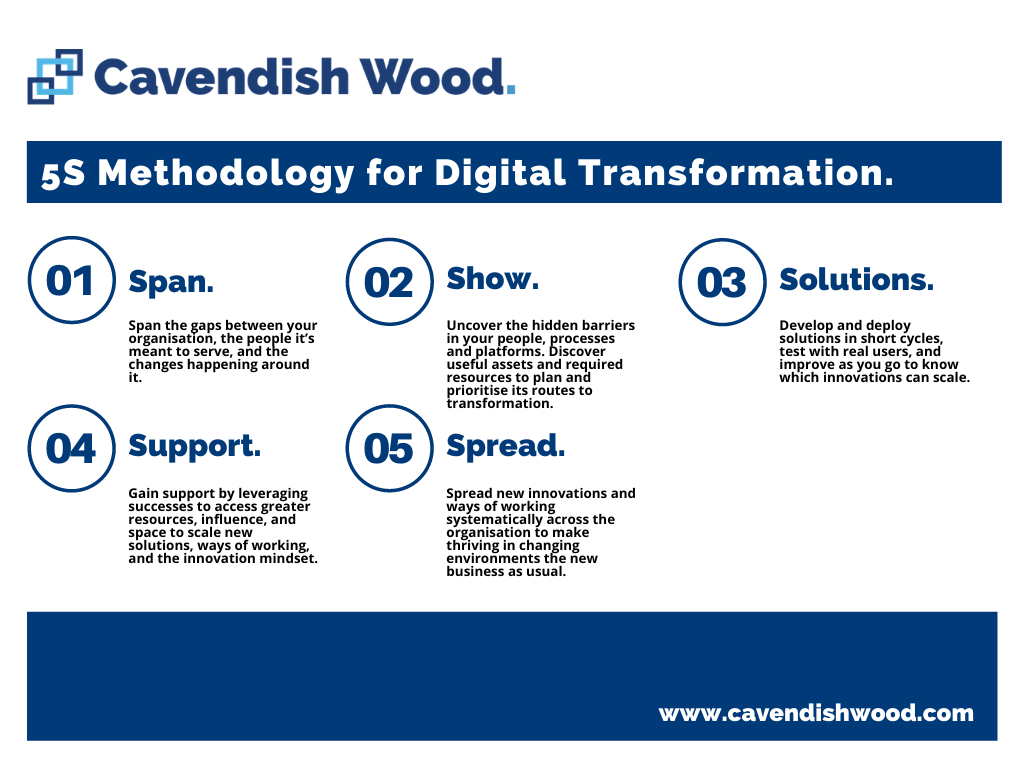
For CEOs, Senior Business Leaders, CIOs and CTOs navigating the complex landscape of digital transformation in the UK's private sector, you've likely already traversed the initial stages of the "5S Framework for Digital Transformation."
Recap of Previous Phases:
- #1 Span: You've established meaningful connections between your organisation and external stakeholders, gathering crucial data to understand what needs to change.
- #2 Show: You've identified the barriers to transformation within your organisation and started to allocate resources effectively.
- #3 Solutions: You've begun to develop solutions iteratively, led by business needs and focused on user experience.
Now, as we move into the fourth phase, "Support," the focus shifts to gaining the backing you need to scale your efforts.

Why support is critical.
In the private sector, having the support of key stakeholders is not just beneficial—it's essential. Whether it's securing additional budget, gaining buy-in from senior leadership, or fostering a culture of innovation among employees, the "Support" phase is where you solidify the foundation for your digital transformation initiatives.
Building a business case.
The first step in gaining support is to build a compelling business case. Use the data and insights gathered in the previous phases to show the ROI of your digital initiatives. In a corporate setting, numbers speak volumes. Demonstrating the financial benefits, efficiency gains, and customer satisfaction metrics can go a long way in securing the support you need.
Engaging senior leadership.
The next crucial step is to engage senior leadership. Their buy-in is often the linchpin for the success of any transformation initiative. Present your business case, share success stories from the initial projects, and outline the strategic vision for digital transformation. Make it clear how these initiatives align with the company's overall business goals.
Cultivating a supportive culture.
Lastly, don't underestimate the power of a supportive organisational culture. Encourage cross-departmental collaboration, celebrate small wins, and openly share the progress of digital initiatives. A culture that values innovation and is open to change will naturally be more supportive of transformation efforts.

Securing support: The make-or-break phase in the digital transformation journey.
In the private sector, the "Support" phase of digital transformation is a pivotal moment. It's the stage that can either propel your transformation efforts into long-term success or see them fizzle out, leaving you with isolated projects and a return to the status quo.
The importance of sustained momentum.
Once you've achieved some early wins, especially in customer-facing areas, there's a risk of complacency setting in. Stakeholders may assume that the transformation is complete or no longer a priority. This is a dangerous misconception. The moment senior leadership shifts its focus, the progress you've made can quickly unravel.
The fallacy of trickle-down transformation.
Another common pitfall is the belief that a mandate from senior leaders will naturally lead to organisation-wide transformation. This "trickle-down" approach is flawed and jeopardises the gains you've made. Transformation isn't something that happens organically; it requires concerted, ongoing effort.
Leveraging success for greater support.
If you sense that your transformation efforts are gaining traction, now is the time to double down. You have a compelling narrative and successful projects that can serve as leverage points. This is the moment to accelerate your transformation initiatives, secure additional budget, and rally more resources.
Identifying and mitigating new risks.
However, this stage also brings new challenges not present at the outset. These could range from internal resistance scaling with the size of the project to external factors like market volatility affecting your budget. Recognising these potential threats early on is crucial as you work to gain broader support.
The "Support" phase is not just about maintaining the status quo; it's about amplifying your efforts. It's the time to capitalise on your successes, secure the backing you need, and ensure that digital transformation remains a strategic priority across your organisation.

Navigating unmovable barriers.
You'll encounter seemingly insurmountable barriers. These could be legacy systems, contractual obligations with vendors, or deeply ingrained organisational processes. While your project teams have been agile, iterating solutions and making progress, some obstacles simply won't budge.
The vendor lock-in dilemma.
For instance, you may be tied to specific software platforms due to long-term contracts or because they are deeply embedded in your operations. This vendor lock-in can severely limit your ability to adapt or integrate new solutions, making these platforms immovable barriers to your transformation efforts.
The risk of stagnation.
The presence of such unmovable barriers can be demoralising for teams and stakeholders. It can lead to a sense of defeatism, where people feel that meaningful change is impossible as long as these barriers exist. This mindset is a significant risk, as it can halt the momentum of your transformation initiatives.
Strategic workarounds.
While you may not be able to remove these barriers, you can strategise ways to work around them. This could involve creating parallel processes, utilising API integrations where possible, or even re-evaluating the cost-benefit analysis of breaking a vendor contract in favour of a more flexible solution.
Communicate and realign.
It's crucial to communicate transparently about these barriers and the steps being taken to mitigate their impact. This can help realign expectations and renew commitment to the transformation objectives.
While unmovable barriers pose a significant challenge, they are not a dead end. Acknowledge them, strategise around them, and continue to push for transformation within the realms of what is achievable. Keep the dialogue open and maintain the momentum, ensuring that these barriers become detours rather than roadblocks in your digital transformation journey.

Managing resistance to change.
Change resistance is a universal phenomenon, and it's particularly pronounced during periods of significant transformation. In the private sector, this resistance can manifest in various ways, from passive non-compliance to active obstruction. Understanding the root causes of this resistance is crucial for navigating it successfully.
The psychology of resistance.
People may resist change for a multitude of reasons. It could be fear of job loss, a perceived increase in workload, or simply an aversion to change. The resistance is often emotional and deeply rooted in concerns about how the transformation will affect them personally.
The importance of empathy.
It's essential to approach resistance with empathy rather than confrontation. Understand that these individuals are not 'roadblocks' but rather stakeholders whose concerns need to be addressed.
Data-driven dialogue.
When dealing with resistance, especially from those who may feel their roles are threatened, it's crucial to rely on data and evidence. Present the benefits of the transformation in a factual, structured manner. Show how the changes have improved efficiency, cost savings, or customer satisfaction in other parts of the organisation.
Transparency is key.
Be as transparent as possible about the reasons for the change and how decisions are made. If someone's role is genuinely at risk, it's crucial to communicate this clearly and that the decision-making process is transparent and evidence-based.
Tailored communication.
Different stakeholders will have different concerns, so tailor your communication to address these specifically. For example, if a team is worried about workload, show how the new system will automate many of their tasks and free them up for more value-added activities.
Resistance to change is a natural human reaction and should be managed, not combated. By approaching it with empathy, relying on data, and maintaining transparency, you can turn resistance into engagement, ensuring that your digital transformation initiative gains the broad support it needs to succeed.

Navigating major changes.
Digital transformation is not just about technology; it's about changing the entire way a business operates and delivers value to its customers. This often involves significant changes that can be disruptive and unsettling for employees. Here's how to manage major changes effectively.
The fear of the unknown.
Major changes, such as restructuring teams, adopting new technologies, or even changing company culture, can be daunting for employees. The unknown aspects of these changes can create anxiety and resistance.
The power of evidence-based success stories.
One of the most effective ways to combat this resistance is to use evidence-based success stories from other areas of the organisation where transformation has already been successful. Demonstrating real-world examples of how these changes have led to positive outcomes can be a powerful tool in gaining buy-in.
Incremental vs radical change.
While the end goal might be a radical transformation, consider an incremental approach to get there. Breaking down the change into smaller, manageable parts can make the process less overwhelming and more palatable to your team.
Inclusive planning.
Involve employees in the planning stages of these major changes. When people feel like they are part of the decision-making process, they are more likely to support the change.
Clear communication.
Be transparent about why the change is necessary, what it will entail, and how it will benefit the organisation in the long run. Clear, consistent communication is key to alleviating fears and misconceptions.
Training and support.
Offer ample training and resources to help employees adapt to new systems or processes. Support from leadership during this period is crucial for a smooth transition.
Monitor and adjust.
Once the changes are implemented, closely monitor their impact. Be prepared to make adjustments as needed and to address any issues promptly.
Major changes are often necessary for transformation but can be a source of significant resistance. By using evidence-based success stories, involving employees in the planning, and communicating clearly, you can navigate these challenges effectively and keep your transformation efforts on track.

Leveraging success stories for sustained support.
Digital transformation is a marathon, not a sprint. As you navigate through the complexities of change, one of your most potent tools for gaining and maintaining momentum is the power of success stories. Here's how to strategically use them to win over stakeholders and secure the resources you need.
Types of success stories.
- Project Successes: These are your quantifiable wins. Whether it's cost savings, efficiency gains, or revenue increases, these success stories are your hard evidence that transformation is more than just a buzzword. It's delivering real value to the business.
- People Successes: These are the qualitative wins that humanise your transformation journey. They could be testimonials about how a new tool has made someone's job easier or how a new process has improved customer satisfaction.
Utilising success stories for strategic support.
In the private sector, the 'Support' phase of digital transformation is not merely a footnote or a communications afterthought. It's a pivotal stage that demands a meticulously crafted campaign to win over stakeholders, secure additional resources, and maintain the momentum of your transformation initiatives. Here's how to strategically use success stories to achieve these objectives.
Crafting a targeted 'support' campaign.
- Identify the Right Stories for the Right People: For instance, if your customer service team is overwhelmed with calls and juggling multiple systems, their immediate needs might be around data rationalisation and self-service capabilities. Use success stories that resonate with these specific pain points to trigger a sense of 'FOMO' (Fear Of Missing Out).
- Align with Your Shared Vision: Use your overarching transformation goals to prioritise which business areas need immediate attention and support. Tailor your success stories to align with these priorities.
- Set Measurable Goals and KPIs: Whether it's increasing project participation rates or securing additional budget, set specific, measurable goals to gauge the effectiveness of your campaign.
Iterative and creative approaches.
- Test and Adapt: Treat your 'Support' campaign like an iterative project. Experiment with different storytelling techniques, channels, and formats to find what resonates most with each stakeholder group.
- Influence Through the Ranks: If you struggle to get through to a key decision-maker, focus on influencing their immediate team or trusted advisors. They are often the ones dealing with the day-to-day challenges that your digital initiatives can solve.
- Identify and Recruit Digital Champions: As you roll out your campaign, you'll likely discover individuals who are particularly enthusiastic about digital transformation. Engage them as business or product owners for future projects.
Engaging senior leadership.
- Include the Power Brokers in Your Plan: Your campaign must extend to the C-suite and other senior leaders who control the budget and resources you need. Use your most compelling, data-backed success stories to make a strong business case for continued investment in digital transformation.
- Be Transparent and Data-Driven: Use the metrics and KPIs you've set to provide regular updates to senior leadership. This not only keeps them in the loop but also reinforces the value and ROI of the transformation efforts.
In summary, the 'Support' phase is your opportunity to capitalise on the successes you've achieved so far. It's about turning these individual wins into a compelling narrative that secures the resources and buy-in you need to scale your digital transformation efforts. Use your success stories not just as testimonials, but as strategic assets in your ongoing transformation journey.
Look out for our final instalment of this series, where we will look at the "Spread" stage.
In "Spread," the focus shifts from individual projects and departments to the organisation as a whole. It's about taking the best practices, solutions, and successes you've achieved and scaling them. This is the stage where you move from transformation as a project to transformation as a culture. Click here to read "Spread" now.

